I’ve been a content writer for SaaS for almost a decade now….well, I mean, a freelancer, not just a writer.
This was my first and only niche as a writer, and I must love it since I’ve stuck with it for all these years. Maybe you’re interested in this writing niche and want to see what it’s all about.
As a SaaS writer, I learned how important content writing is for a marketing strategy, not only with my own business but also with B2B SaaS companies.
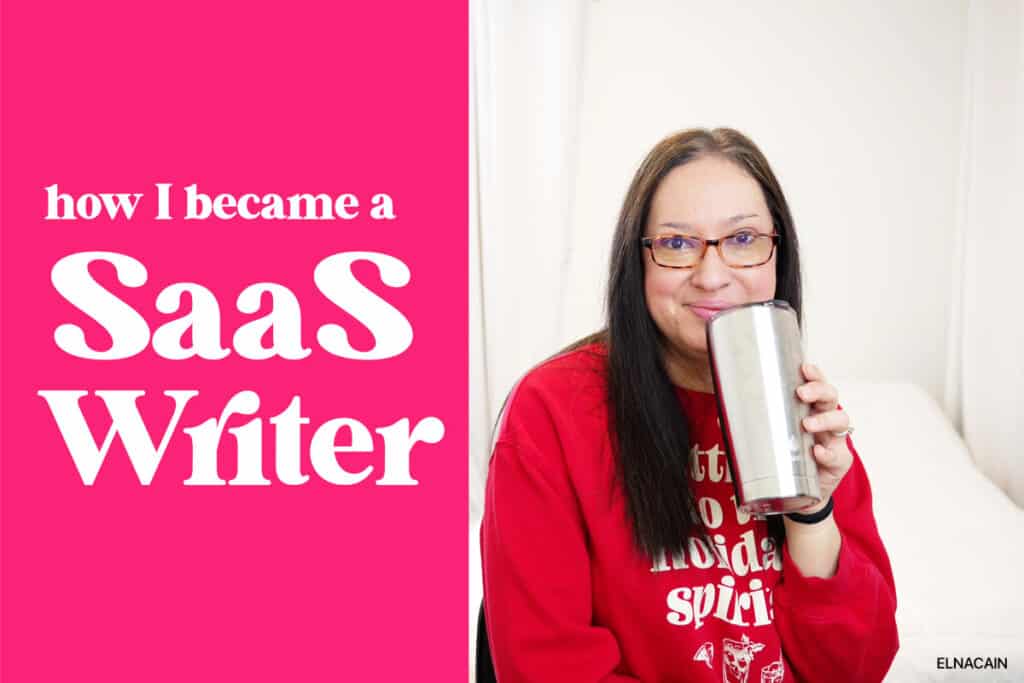
Content for these businesses is what helps drive their brand and sales.
And many SaaS brands will spend tens of thousands a month on content creation.
Why?
Because they want to spread the word about their SaaS product and gain leads with their helpful content that educates their audience about the benefits and features of their product.
This is similar to what I do with my audience.
I educated y’all about freelance writing, and doing that helped you decide if my digital products are for you.
So, let’s go into my story about my SaaS content writing service and learn how to write for a SaaS company (if this is your jam, too).
What is SaaS and SaaS Writing?
SaaS stands for software as a service.
This means it’s a piece of software and something you can’t touch. It “lives” in the cloud, and you access it on your web browser.
Imagine you’re using an app like Netflix or Gmail. Instead of buying and installing the software on your computer, you access it online and pay a subscription fee.
That’s SaaS!
You can buy this type of software, ‘rent,’ or make monthly payments, or pay a subscription fee.
So, when writing for SaaS, you’re creating certain types of content for companies that offer these online software services.
As a SaaS freelance writer, you might write:
- blog posts
- website copy
- white papers
- case studies
- landing pages
- email copy
- ad copy
- social media content
All of this content helps these companies explain their products, attract customers, and informs them.
Much of the content is also technical, so many freelance and SaaS content writers are tech or eCommerce writers since these SaaS products integrate with them.
You can pair SaaS with practically any industry – B2B or B2C.
For B2B SaaS and B2C SaaS, you have:
- Customer relationship management (CRM)
- Enterprise resources planning (ERP)
- Accounting software
- Project management software
- CMS and e-commerce platforms
- Communication platforms
- Marketing services
- Sales/Revenue growth services
- HR/HRM solutions
- Payment gateways and billing solutions
- Social automation services
- Email service providers
- AI tools
- SEO services
- Course creation platforms
- Digital product platforms
The list can go on and on.
My B2B SaaS Content Writing Story
When I started freelance writing in 2014 and landed a gig with Blogging Wizard to write about content marketing and digital marketing ideas, I called my content service digital marketing writing services.
And for years, I stuck with this freelance title.
Later, I defined the companies I wrote for as digitally native brands. It wasn’t until recently I noticed the rise of the B2B SaaS writer.
I saw more and more freelance writers talking about B2B SaaS and terming themselves as such. I had to do a quick Google search for my clients and see if they were connected with SaaS, and they were!
That meant I could name my service SaaS blog content writing services.
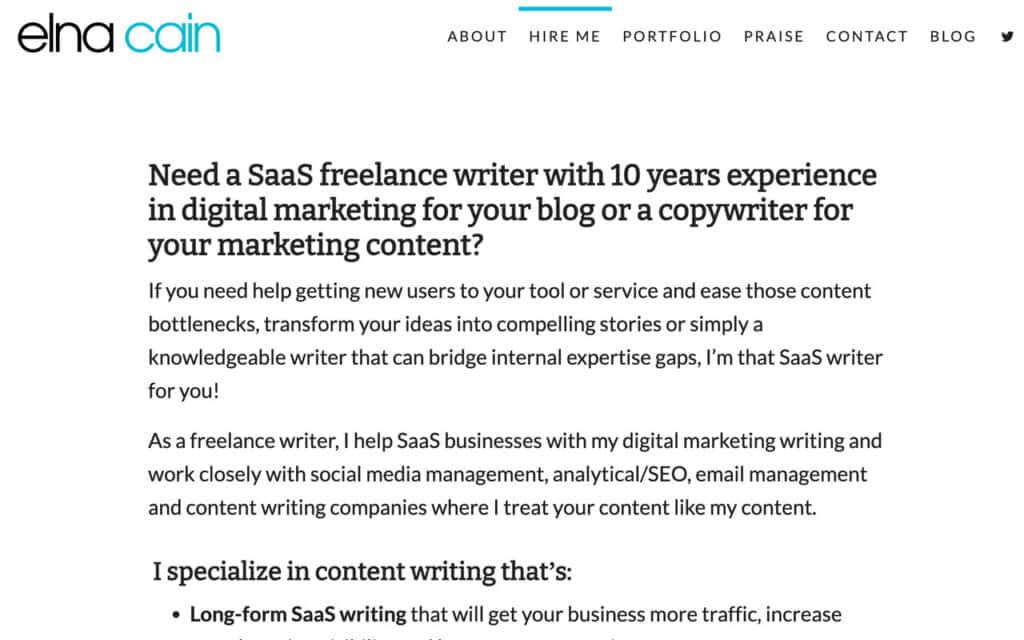
And while I kept redefining my writing services over time, I was able to raise my rates.
I went from getting $.10/word to $.50/word and more. Practically every piece of content I give a client is around $1,000 or more.
This rate wasn’t solely because of saying I was a B2B SaaS writer either; I added more skills and even copywriting that helped elevate my status as a writer.
So, if you want to market yourself as a SaaS content writer, once you pick an industry or SaaS company to pitch to, state the writing niche or service you provide.
Some examples of services you might market are:
- SEO Content Writing Services for SaaS – providing SEO content for SaaS brands
- White Paper & Case Study SaaS Writing Services – Only writing white papers or case studies for SaaS companies to help them grow their leads
- B2B SaaS Long-Form Blog Content Writing Services – providing researched-driven blog content that’s long-form
All About Content Writing for SaaS Companies
If you’re interested in how to write for SaaS companies, let’s look at the specific features of a SaaS content writing freelancer article.
1. You Need to Be Familiar With the SaaS Tool or Product
Many writers may not pick the SaaS industry to write for because of all the tools you may need to use and know. If you’re tech-challenged and not interested in using digital tools or services, then SaaS writing isn’t for you.
Over the years, I’ve learned about many SaaS products like SEO, analytical, AI writing tools, email marketing services, and more.
This helps me understand my client better and equips me for when I write product-led blog posts. Now, I don’t write those often, but when I do, it’s only because I’m familiar with the tool.
For example, I wrote an in-depth review of using Teachable, a course platform for creatives.
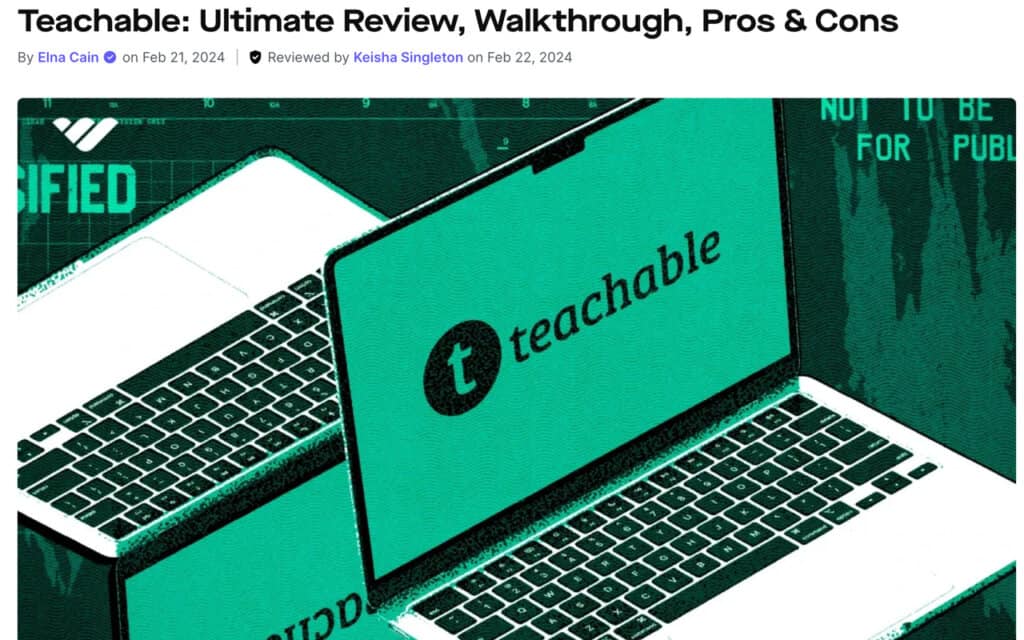
Some SaaS writing clients ask you to round up tools, apps, products, or services.
When they do, it’s up to the freelance writer to research each SaaS product’s features, benefits, and pros and cons. So, even if you aren’t familiar with ALL the SEO tools or the project management apps, you can Google it and ask around!
2. You Write Content in All Areas of the Sales Funnel
Any business that wants to generate revenue needs a strong sales funnel. And, if they are online, they’ll need a content sales funnel with ToFu, MoFu, and BoFu content.
What the heck am I speaking of?
ToFu means Top of the Funnel content, which implies educational and informative content.
People may not know the SaaS product and just want information about their problems. For example, if a creator wants to monitor their social influence, they may search for a guide.
The results in Google show three social media monitoring tools that a creator can use to learn about the topic and then learn about the tool.
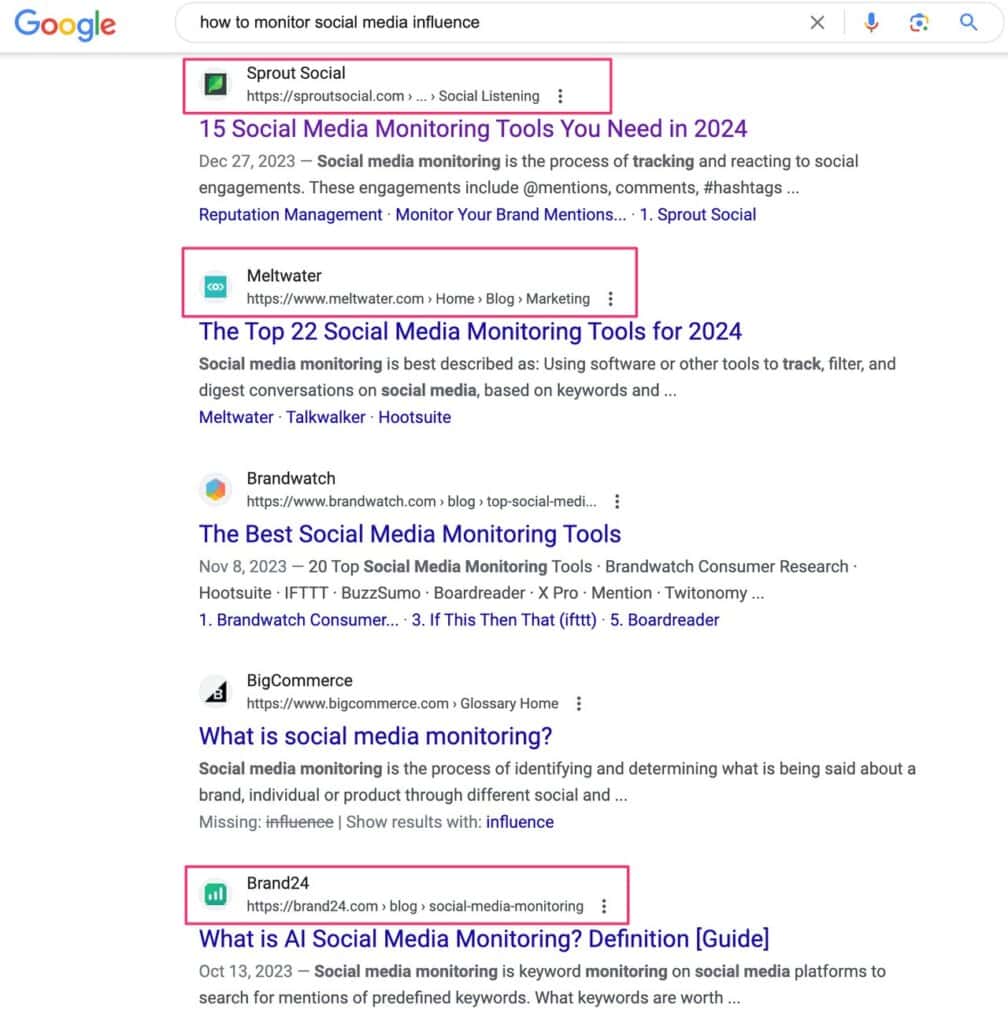
This is ToFu content to help them decide if they ACTUALLY need a social media monitoring tool.
ToFu content is attracting the right type of audience that may not be aware of a particular company. Essentially, the audience is looking for information, answers, and insights.
MoFu content is Middle of the Funnel content and is more in-depth in the buying journey.
This type of content further educates and nurtures that sale from a user. It helps users understand the product better and address their questions and pain points.
MoFu content includes fewer blog posts and more targeted email campaigns, white papers, free workshops, or trials.
But you can create MoFu blog posts by doing comparison guides.
While many companies don’t want to highlight competitors, many will because they must.
In my research about Teachable, I HAD to learn how Teachable is different from other course platforms like Kajabi or Thinkific. And I’m not the only one thinking this.
Just search two products with vs. in between to see blog post after blog posts in the search result pages (SERPS).

Middle of the funnel content is difficult for many freelance writers. I know I stayed away from comparison posts, but there was always a writer to pick up that content piece, so just because I don’t like doing this type of writing doesn’t mean you should, either!
The last part of the sales funnel is BoFu, or Bottom of the Funnel content. This is when a person is ready to purchase the SaaS product.
Content like case study success stories, FAQ pages, onboarding customer guides, and emails are examples of BoFu content.
Freelance writers also write BoFu blog posts, most of which are about product features or demonstrating the benefits of using the product. Most SaaS companies hire internally for BoFu content, so when you can market yourself as a BoFu SaaS writer, you’ll pique the interest of many SaaS marketers and content leads.
3. Audience Are Key Decision Makers
The SaaS audience is typically business owners or key decision-makers.
They want to know about products, apps, or tools and take the time to invest in the content or engage in free trials. For example, Strut is an all-in-one workspace for writers.
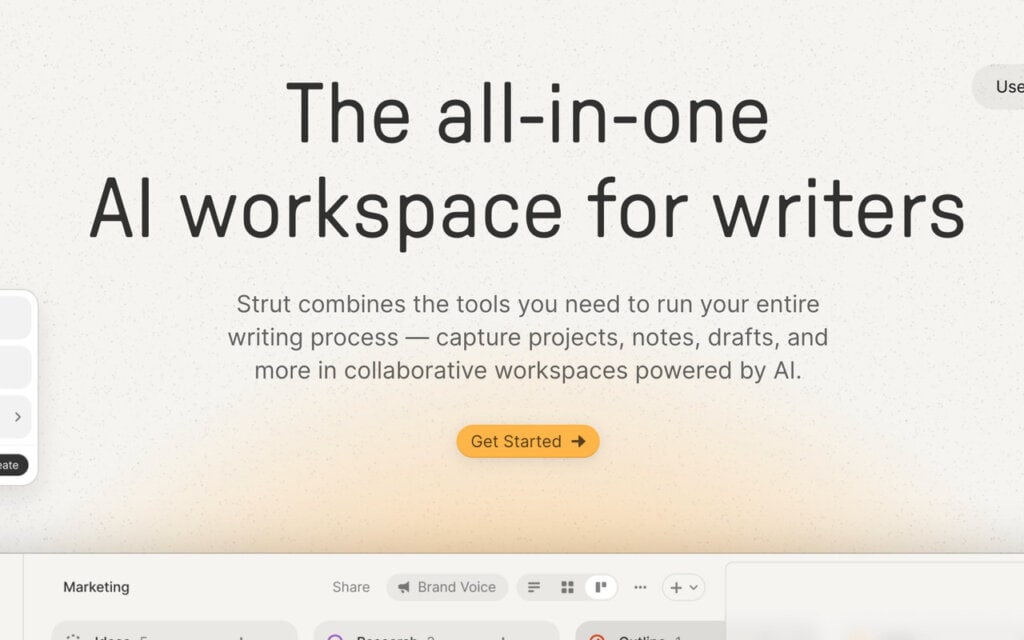
I was intrigued when I saw them on X/Twitter, so I clicked on them and signed up for a free trial.
Since it is a new company, the owners are mostly looking for feedback from its users to help it later with its product and brand messaging. But, as a SaaS writer, it’s important to understand who the audience is when writing content about a tool or app.
Most of the content on a SaaS blog is ToFu, so you’re approaching them as newcomers to this space. This means not using jargon or difficult terminology when writing.
Instead, you’re demonstrating and describing in your blog post so that a user can understand exactly what you’re saying. So, this might mean taking something that’s tech-related and making it easy-to-read and conversational. This is a content writing skill that can be learned.
4. The Writing is Long Form
Since the sales cycle for B2B is typically longer than for B2C, it stands to reason that the articles on a blog are highly comprehensive.
The topics also need a lot of support regarding data, research, and quotes. For a while, I was only taking on short projects because of how exhaustive the process is to write a long-form data-driven blog post.
But this year, I decided to go back to ‘my roots’ and write long-form content for SaaS companies.
Because SaaS content writing is long-form, it’s also high-paying. Content leads want a writer versed in long-form writing and understanding the product and industry.
All of that comes with a premium rate.
5. SaaS Content Can Involve Tech Writing
While I haven’t explored much tech writing as a SaaS freelancer, I know many writers specializing in SaaS and tech.
When writing tech for a SaaS company, you’re probably doing a deep dive into the client’s product or tool. For example, Positional is a SaaS toolset to help startups grow with SEO.
Many of their content articles are tech-related to help startups handle any mishaps with their websites.

To write this type of content, a SaaS freelancer must have:
- Deep technical knowledge of various tools or your industry. For example, to write tech-related posts for an SEO tool or web analytics tool, you need to understand the nuances of how search engines crawl and index web pages or the impact of different website architectures on SEO.
- Strong analytical skills. This means analyzing any data associated with your content piece and using it to help you break down the important things the audience needs to know.
- Clear and concise writing. This goes without saying for any freelance writing niche, but it’s especially true for a technology writer. You’ll need to explain complex concepts in a way that’s easy to understand. This means breaking down technical jargon into simpler terms and using examples and analogies to clarify what you are writing about.
As a SaaS writer, if this type of writing is up your alley, make sure to title yourself as a SaaS tech writer to score some high-paying gigs.
6. SaaS Writing Often Targets SEO
For any business online, SEO is a built-in tactic for their content marketing strategy. SEO – Search Engine Optimization – means targeting a phrase or keyword to rank in Google
Most businesses choose keywords that will help users find out about their product or tool.
For example, one of my older clients, OptinMonster, is interested in ranking for email-related keywords

Why? Because their tool is a lead generation software to help grow leads and email subscribers.
As a freelance SaaS writer, you will need to know how to add keywords to your content so that it can rank for your client.
7. SaaS Writing Can Incorporate Journalistic Writing
One thing I’m noticing more and more is that SaaS writers are doing journalist-style writing for their clients. While this is still long-form SEO writing, it also has elements of journalist writing, like using quotes or subject matter expert interviews.
I started noticing this about two years ago, and since then, I’ve made it a mission to incorporate more journalistic writing into my SaaS content.
So, what does this look like?
Let’s break it down:
1. Incorporating Polls or Surveys
A journalist hunts down stories for their article, and data can help support what they are sharing. Data like number of sales, users or key findings about a topic can demonstrate your points in your article.
Sometimes, clients will have data on their products that you can use to write the article.
Other times, you may have to find the story by posting a poll or survey on LinkedIn or X/Twitter for some unique content.
2. Using Subject Matter Experts
One of the best ways to add journalistic style writing is to incorporate some SMEs into your content.
These subject matters can level-up your content to make it more valuable and credible. To find the right SME, you can search the industry and experts.
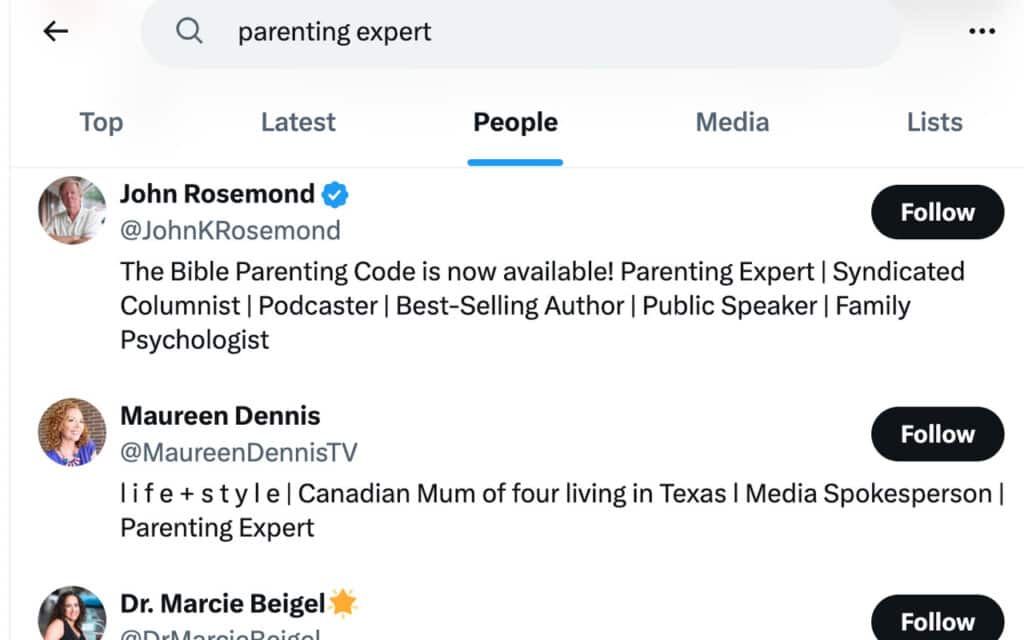
You can also source SMEs on podcasts, as many enjoy discussing their business and brand.
Once you start finding SMEs, go ahead and create a swipe file and make a list of the email addresses and profiles of SMEs so you can reach out to them throughout the year.
3. Using Customer Questions/Answers
Some of the best information you can get is from actual product users. What questions or answers do they have that you can add to your SaaS content article?
For many of my GoDaddy blog posts, I use customer questions and answers that add valuable information for someone interested in using GoDaddy.
Ins and Outs of Becoming a SaaS Freelance Writer
There ya go!
This is how I slowly became a specialized writer for SaaS brands. From learning how to write for SaaS companies to defining my role and title, it was a worthwhile journey for sure!
I hope you enjoyed this post!
Let me know in the comments if you are also a SaaS writer! I’d love to hear how you lucked into this niche.




Leave a Reply